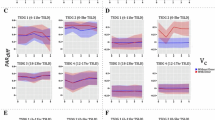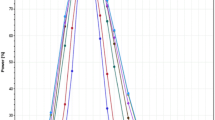Abstract
In traditional pharmacokinetic (PK) bioequivalence analysis, two one-sided tests (TOST) are conducted on the area under the concentration-time curve and the maximal concentration derived using a non-compartmental approach. When rich sampling is unfeasible, a model-based (MB) approach, using nonlinear mixed effect models (NLMEM) is possible. However, MB-TOST using asymptotic standard errors (SE) presents increased type I error when asymptotic conditions do not hold. In this work, we propose three alternative calculations of the SE based on (i) an adaptation to NLMEM of the correction proposed by Gallant, (ii) the a posteriori distribution of the treatment coefficient using the Hamiltonian Monte Carlo algorithm, and (iii) parametric random effects and residual errors bootstrap. We evaluate these approaches by simulations, for two-arms parallel and two-period, two-sequence cross-over design with rich (n = 10) and sparse (n = 3) sampling under the null and the alternative hypotheses, with MB-TOST. All new approaches correct for the inflation of MB-TOST type I error in PK studies with sparse designs. The approach based on the a posteriori distribution appears to be the best compromise between controlled type I errors and computing times. MB-TOST using non-asymptotic SE controls type I error rate better than when using asymptotic SE estimates for bioequivalence on PK studies with sparse sampling.




Similar content being viewed by others
References
US Department of Health and Human Services and others. FDA guidance for industry, statistical approaches to establishing bioequivalence. https://www.fda.gov/media/70958/download. 2001.
EMEA C. Note for guidance on the investigation of bioavailability and bioequivalence. CPMP/EWP/QWP/1401/98, London; 2001.
Schuirmann DJ. A comparison of the two one-sided tests procedure and the power approach for assessing the equivalence of average bioavailability. J Pharmacokinet Biopharm. 1987;15(6):657–80.
Shen M, Machado SG. Bioequivalence evaluation of sparse sampling pharmacokinetics data using bootstrap resampling method. J Biopharm Stat. 2017;27(2):257–64.
Dubois A, Gsteiger S, Pigeolet E, Mentre F. Bioequivalence tests based on individual estimates using non-compartmental or model-based analyses: evaluation of estimates of sample means and type I error for different designs. Pharm Res. 2010;27(1):92–104.
Gallant AR. Seemingly unrelated nonlinear regressions. J Econ. 1975;3(1):35–50.
Bertrand J, Comets E, Chenel M, Mentre F. Some alternatives to asymptotic tests for the analysis of pharmacogenetic data using nonlinear mixed effects models. Biometrics. 2012;68(1):146–55.
Stan Development Team. RStan: the R interface to Stan, Version 2.12.0; 2016. http://mc-stan.org/.
Ueckert S, Riviere MK, Mentre F. Improved confidence intervals and P-values by sampling from the normalized likelihood. J Pharmacokinet Pharmacodyn. 2015;42:S56–7.
Thai HT, Mentre F, Holford NH, Veyrat-Follet C, Comets E. A comparison of boot-strap approaches for estimating uncertainty of parameters in linear mixed-effects models. Pharm Stat. 2013;12(3):129–40.
Tsai CA, Huang CY, Liu JP. An approximate approach to sample size determination in bioequivalence testing with multiple pharmacokinetic responses. Stat Med. 2014;33(19):3300–17.
Mollenhoff K, Loingeville F, Bertrand J, Nguyen TT, Sharan S, Sun G, et al. Efficient model-based bioequivalence testing. Biostatistics. 2020. https://academic.oup.com/biostatistics/article-abstract/doi/10.1093/biostatistics/kxaa026/5874612.
Oehlert GW. A note on the delta method. Am Stat. 1992;46(1):27–9.
Dubois A, Lavielle M, Gsteiger S, Pigeolet E, Mentre F. Model-based analyses of bioequivalence crossover trials using the stochastic approximation expectation maximisation algorithm. Stat Med. 2011;30(21):2582–600.
FDA. Guidance for industry: statistical approaches to establishing bioequivalence. Rockville: Center for Drug Evaluation and Research, Food and Drug Administration; 2001.
Liu JP, Weng CS. Bias of two one-sided tests procedures in assessment of bioequivalence. Stat Med. 1995;14(8):853–61.
Panhard X, Mentre F. Evaluation by simulation of tests based on non-linear mixed-effects models in pharmacokinetic interaction and bioequivalence cross-over trials. Stat Med. 2005;24(10):1509–24.
Genz A, Bretz F, Miwa T, Mi X, Leisch F, Scheipl F, et al.. mvtnorm: multivariate normal and t distributions; 2020. R package version 1.1–1. Available from: https://CRAN.R-project.org/package=mvtnorm.
Comets E, Lavenu A, Lavielle M. Parameter estimation in nonlinear mixed effect models using saemix, an R implementation of the SAEM algorithm. J Stat Softw. 2017;80:1–42.
Monolix version 2018R2 . Antony, France: Lixoft SAS; 2018. http://lixoft.com/products/monolix/.
Haidar SH, Makhlouf F, Schuirmann DJ, Hyslop T, Davit B, Conner D, et al. Evaluation of a scaling approach for the bioequivalence of highly variable drugs. Am Assoc Pharm Sci J. 2008;10(3):450–4.
Davit BM, Chen ML, Conner DP, Haidar SH, Kim S, Lee CH, et al. Implementation of a reference-scaled average bioequivalence approach for highly variable generic drug products by the US Food and Drug Administration. Am Assoc Pharm Sci J. 2012;14(4):915–24.
Buatois S, Ueckert S, Frey N, Retout S, Mentre F. Comparison of model averaging and model selection in dose finding trials analyzed by nonlinear mixed effect models. AAPS J. 2018;20(3):56.
Maurer W, Jones B, Chen Y. Controlling the type I error rate in two-stage sequential adaptive designs when testing for average bioequivalence. Stat Med. 2018;37(10):1587–607.
Funding
This work was supported by the Food and Drug Administration (FDA) under contract 75F40119C1011. The authors thank FDA for this funding. The work of H. Dette was supported in part by the Collaborative Research Centre “Statistical modelling of nonlinear dynamic processes” (SFB 823, Teilprojekt T1) of the German Research Foundation (DFG).
Author information
Authors and Affiliations
Corresponding author
Ethics declarations
Disclaimer
The views in this paper do not necessarily reflect the views or policies of the FDA.
Additional information
Publisher’s Note
Springer Nature remains neutral with regard to jurisdictional claims in published maps and institutional affiliations.
Rights and permissions
About this article
Cite this article
Loingeville, F., Bertrand, J., Nguyen, T.T. et al. New Model–Based Bioequivalence Statistical Approaches for Pharmacokinetic Studies with Sparse Sampling. AAPS J 22, 141 (2020). https://doi.org/10.1208/s12248-020-00507-3
Received:
Accepted:
Published:
DOI: https://doi.org/10.1208/s12248-020-00507-3




